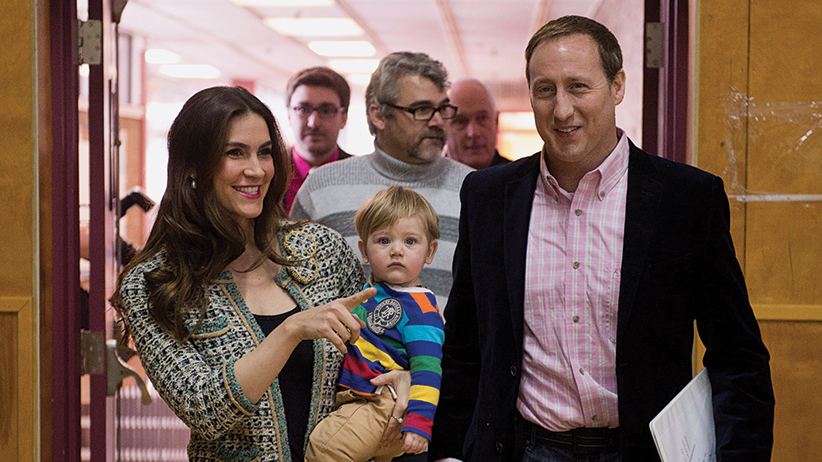Peter MacKay and the trouble with women
Peter MacKay touched a nerve with an old-timey Mother’s Day email. But is he really the problem?
Canada’s Justice Minister Peter MacKay pauses while speaking during Question Period in the House of Commons on Parliament Hill in Ottawa June 11, 2014. Chris Wattie/Reuters
Share

Peter MacKay’s controversial tribute to working women, and the many responsibilities they juggle—changing dirty diapers, filling lunch boxes, dropping off kids at school and planning dinner—seems to have left something out: saving the minister of justice from himself. In an open letter, published on the Globe and Mail’s website late last week, Nazanin Afshin-Jam MacKay, the politician’s wife and mother of their young son, Kian, slammed critics who are painting him as sexist and out of touch. Blaming “the 24-hour news cycle, National Enquirer-TMZ mentality,” the human rights activist and former Miss World Canada wrote that her husband is a being pilloried for a Mother’s Day tribute email that was actually drafted and approved by female department staffers. Furthermore, she claimed that his contentious remarks linking a dearth of women judges to their strong maternal instincts, made before an audience of lawyers, were never uttered. “He said no such thing,” read the letter.
Also riding to the rescue was MacKay’s colleague Kelly Leitch, one of 12 women in Prime Minister Stephen Harper’s 39-member cabinet. The minister of labour and status of women happened to unveil a new plan to encourage Canadian businesses to appoint more women to their corporate boards on the same day as the open letter. “Women need champions and mentors,” Leitch told Maclean’s, citing a need for wider and more inclusive searches for executives. “We’ve got to create a pipeline.” It’s an area where the Conservative government has been leading by example, she added, noting that 31 per cent of those occupying appointed positions on federal boards, tribunals and agencies are now women.
Unfortunately, that’s actually a decrease from the last three years of the previous Liberal government, 2002-05, when 37 per cent of those jobs were held by women, and the first four years under Tory rule, when the figure was 32.5 per cent. Confronted with the numbers, Leitch blamed the drop on varying term lengths, and said the government “is constantly aspiring for higher.”
The reality is that Ottawa is among the country’s more equitable employers. Fifty-five per cent of the government’s 263,000 bureaucrats are women—up 13 percentage points from the mid-1980s—as are 45 per cent of its executives. (According to the 2006 census, women make up 52.3 per cent of the available workforce.) They receive 57.6 per cent of the promotions the government gives out, and now occupy 41.5 per cent of the jobs that pay $100,000 or more.
But that hasn’t stemmed complaints about its actions and attitudes. Robyn Benson, national president of the Public Service Alliance of Canada (PSAC), the union that represents the vast majority of those workers, cites a long list of “anti-women” decisions and policies, starting with Harper’s cancellation of a planned national child care program right after he took office. And, within the bureaucracy, moves to restrict pay equity complaints, and ongoing downsizing efforts she claims disproportionately target women, have created a climate of stress and fear. “We’ve been hearing from young women who are expecting their first child, but are hiding it because they are afraid they will be asked to leave,” says Benson. “Step-by-step, this government is stripping away the major gains that women have made over the past 30 years.”
Carol Agócs, professor emerita of political science at Western University, noted that it wasn’t that long ago when Canada’s public service was overwhelmingly male, white, English-speaking, and from a middle- or upper-middle-class background. “We’ve never really had a representative bureaucracy, and we certainly don’t have one now,” she said, particularly with regard to visible minorities. Women occupy a disproportionate percentage of lower-paying clerical and support jobs in the public service; 79 per cent of the RCMP’s civilian staff are female, for example, as are 80 per cent of workers at the National Parole Board. And with the elimination of the mandatory long-form census and cuts to Statistics Canada, it’s becoming harder than ever to identify the underlying trends and reasons. (The Treasury Board’s own annual report on employment equity in public service has shrunk from 68 to 19 pages, in recent years.)
Whatever MacKay said about female lawyers and their desire to become judges—it was a closed-door meeting and no tape or transcript has yet emerged—there is clearly a problem. Just 34 per cent of Canada’s sitting judges are women, and only four of the country’s 31 federally appointed courts can claim gender parity or a female majority. But is this minister really the problem? It’s only been 12 months since MacKay arrived on the job. Before that, Rob Nicholson occupied the position for 6½ years. His predecessor, Vic Toews, was Harper’s first pick for Justice in 2006. (This past March, MacKay appointed him to the Court of Queen’s Bench in Manitoba.) Just two women—Kim Campbell, a Conservative, and Anne McLlellan, a Liberal—have held the job since Confederation.